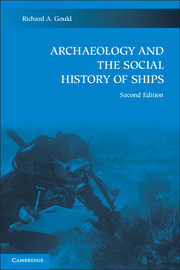Book contents
- Frontmatter
- Contents
- List of figures
- List of tables
- Acknowledgments
- Introduction: Toward a higher standard
- 1 Interpreting the underwater archaeological record
- 2 Underwater archaeology: The state of the art
- 3 Ships and shipwrecks: Basic mechanics
- 4 The archaeology of small watercraft
- 5 The earliest ships
- 6 Shipwrecks and our understanding of ancient trade
- 7 Sailing ships of the Middle Ages
- 8 Ships of the great age of sail
- 9 From sail to steam in maritime commerce
- 10 New technologies and naval warfare
- 11 The archaeology of maritime infrastructure
- 12 The future of shipwreck archaeology
- References cited
- General index
- Ship and site index
6 - Shipwrecks and our understanding of ancient trade
Published online by Cambridge University Press: 05 June 2012
- Frontmatter
- Contents
- List of figures
- List of tables
- Acknowledgments
- Introduction: Toward a higher standard
- 1 Interpreting the underwater archaeological record
- 2 Underwater archaeology: The state of the art
- 3 Ships and shipwrecks: Basic mechanics
- 4 The archaeology of small watercraft
- 5 The earliest ships
- 6 Shipwrecks and our understanding of ancient trade
- 7 Sailing ships of the Middle Ages
- 8 Ships of the great age of sail
- 9 From sail to steam in maritime commerce
- 10 New technologies and naval warfare
- 11 The archaeology of maritime infrastructure
- 12 The future of shipwreck archaeology
- References cited
- General index
- Ship and site index
Summary
Underwater archaeology offers a unique perspective on ancient trade. Shipwrecks provide information about trading behavior and relationships at a distance, in contexts that differ sharply from those on land.
Archaeologist Colin Renfrew (1975: 4) noted that trade “…requires organization as well as commodity,” and he went on to develop a comprehensive theory of trade. His theory was based on a model of exchange involving 10 different modes of trade. Each of these postulated different kinds of patterning of material items in the archaeological record as a result of different ways of organizing trade (Renfrew, 1975: 41–44). For maritime archaeology, however, Renfrew's theory is applicable only to ports of trade and other shore-based facilities.
For maritime archaeologists, the principal loci for evidence of ancient trade occur at points between the nodes of exchange in Renfrew's model. The Bronze Age wrecks at Uluburun and Cape Gelidonya and the Roman-era wreck at Madrague de Giens (along with scores of other Roman-era cargo transports) were the remains of vessels wrecked while en route between points and not necessarily near a point of departure or destination. Renfrew admitted that (1975: 45) “Maritime trade virtually excludes certain modes, such as mode 4 [down-the-line] and it is a truism that rivers or seas may be regarded either as barriers or as easy channels of communication according to the transport available.”
Later, Renfrew proposed distance-decay relationships between items of trade and the distances of those items from their source.
- Type
- Chapter
- Information
- Archaeology and the Social History of Ships , pp. 151 - 170Publisher: Cambridge University PressPrint publication year: 2011



